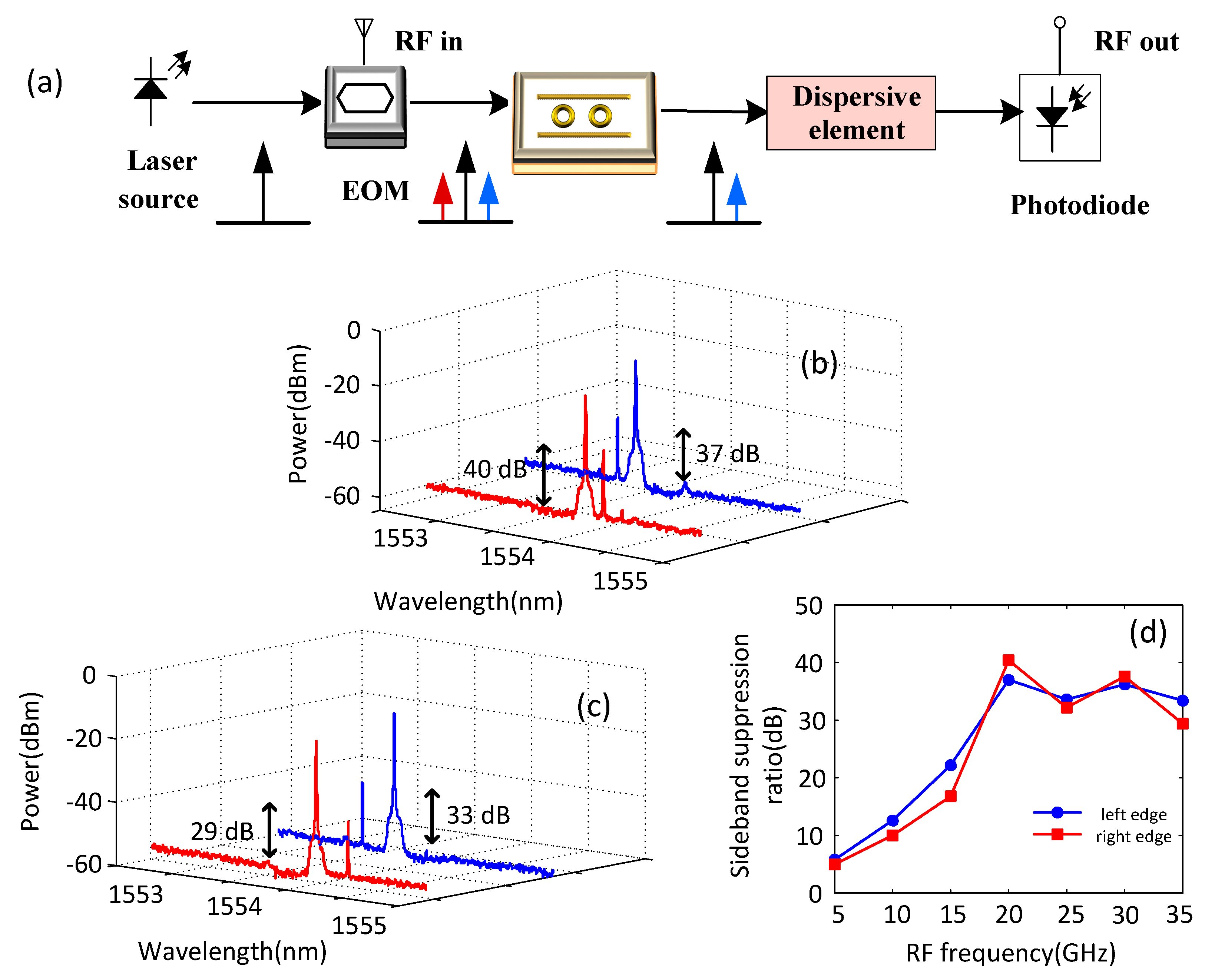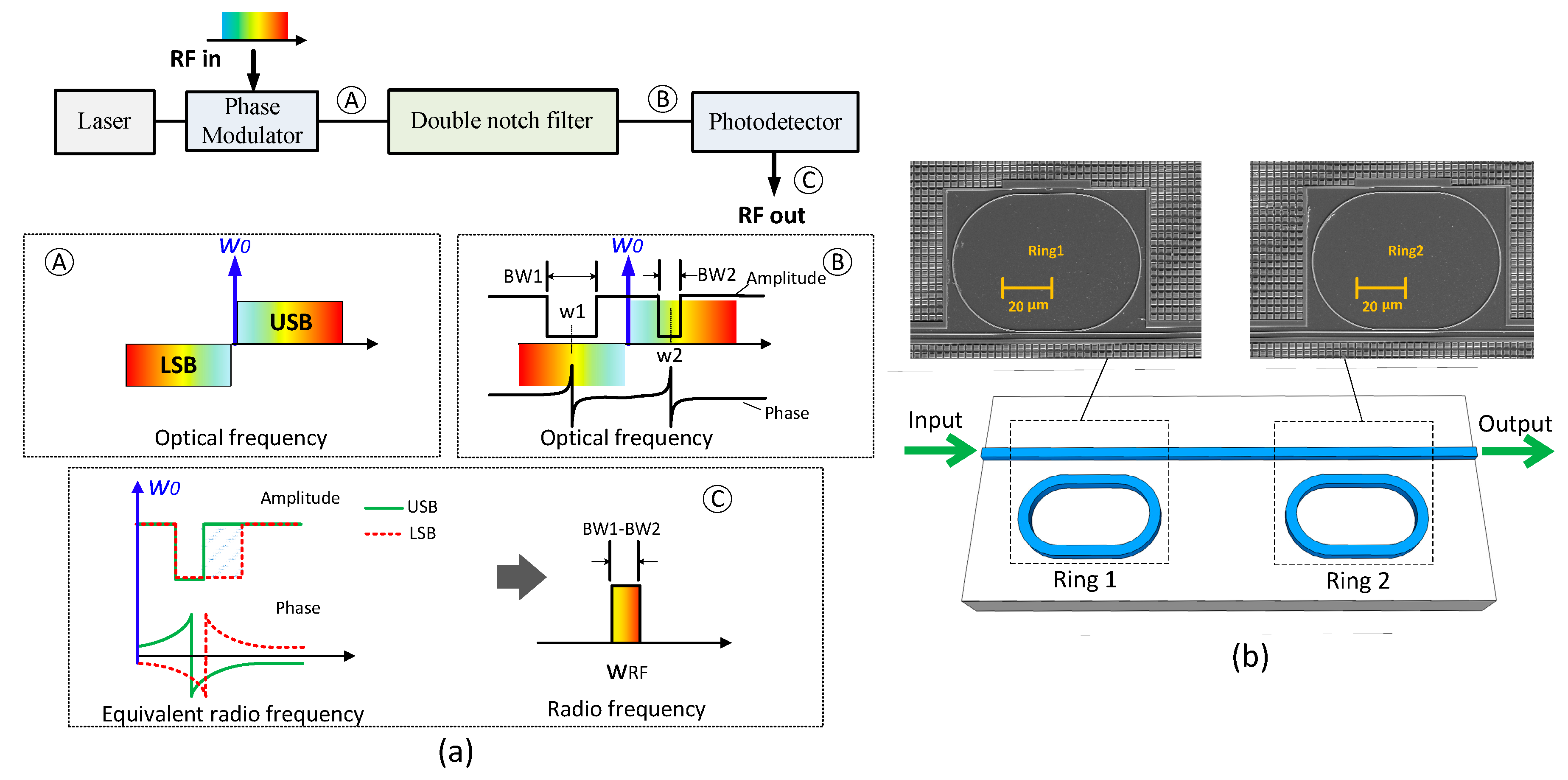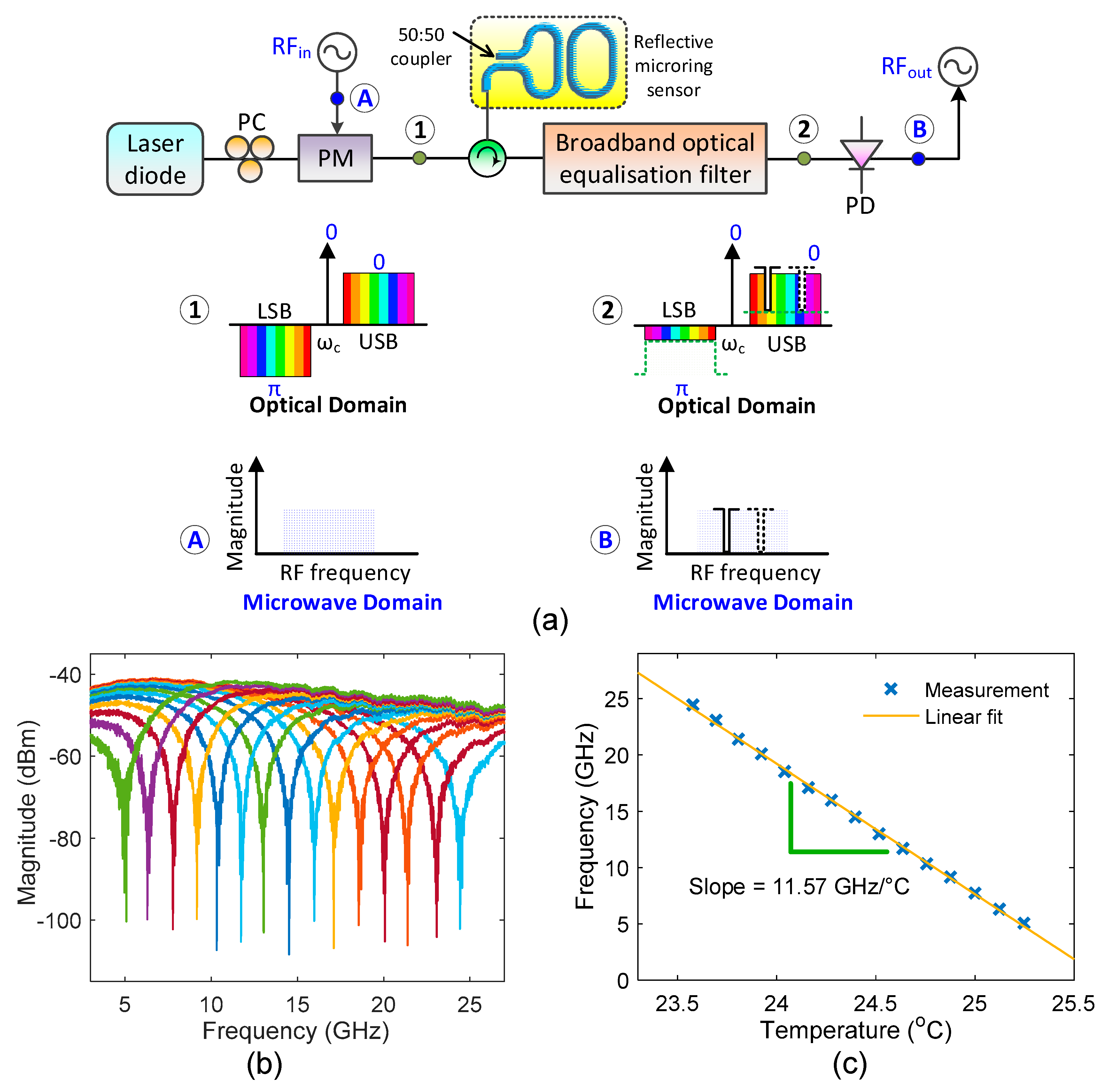Microwave Photonic Signal Processing and Sensing Based on Optical Filtering
Abstract
1. Introduction
2. Optical Filtering for Single Sideband Modulation and Spectral Characterization
3. Optical Filtering for Single Passband Microwave Photonic Filter
4. Microwave Photonic Sensing Based on Optical Filtering
5. Conclusions
Author Contributions
Acknowledgments
Conflicts of Interest
References
- Minasian, R.A. Ultra-wideband and adaptive photonic signal processing of microwave signals. IEEE J. Quantum Electron. 2016, 52, 0600813. [Google Scholar] [CrossRef]
- Capmany, J.; Mora, J.; Gasulla, I.; Sancho, J. Microwave photonic signal processing. J. Lightw. Technol. 2013, 31, 571–586. [Google Scholar] [CrossRef]
- Minasian, R.A.; Chan, E.H.W.; Yi, X. Microwave photonic signal processing. Opt. Express 2013, 21, 22918–22936. [Google Scholar] [CrossRef] [PubMed]
- Zou, X.; Yao, J. Microwave and millimeter-wave measurements using photonics. In SPIE Newsroom; SPIE: New York, NY, USA, 2015; pp. 1–3. [Google Scholar]
- Waterhouse, R.; Novak, D. Realizing 5G: Microwave photonics for 5G mobile wireless systems. IEEE Microw. Mag. 2015, 16, 84–92. [Google Scholar] [CrossRef]
- Urick, V.J. Considerations and application opportunities for integrated microwave photonics. In Proceedings of the Optical Fiber Communications Conference and Exhibition (OFC), Anaheim, CA, USA, 20–24 March 2016; Volume M2B.1, pp. 1–3. [Google Scholar]
- Li, L.; Yi, X.; Huang, T.X. Microwave photonic hybrid phase-time shifter and widely tunable microwave filter. IEEE Photonics Technol. Lett. 2012, 24, 2288–2291. [Google Scholar]
- Capmany, J.; Gasulla, I.; Sales, S. Microwave photonics: Harnessing slow light. Nat. Photonics 2011, 5, 731–733. [Google Scholar] [CrossRef]
- Li, L.; Yi, X.; Huang, T.X.; Minasian, R.A. High-resolution single bandpass microwave photonic filter with shape-invariant tunability. IEEE Photonics Technol. Lett. 2014, 26, 82–85. [Google Scholar] [CrossRef]
- Yi, X.; Huang, T.X.; Minasian, R.A. Photonic beamforming based on programmable phase shifters with amplitude and phase control. IEEE Photonics Technol. Lett. 2011, 23, 1286–1288. [Google Scholar] [CrossRef]
- Leitner, P.; Yi, X.; Li, L.; Huang, T.X. Fully programmable spectrum sliced chirped microwave photonic filter. Opt. Express 2015, 23, 4033–4045. [Google Scholar] [CrossRef]
- Zhang, W.; Yao, J. A fully reconfigurable waveguide Bragg grating for programmable photonic signal processing. Nat. Commun. 2018, 9, 1396. [Google Scholar] [CrossRef]
- Song, S.; Yi, X.; Chew, S.X.; Li, L.; Nguyen, L.; Bian, P. Integrated SOI stagger-tuned optical filter with flat-top response. J. Lightw. Technol. 2016, 34, 2318–2323. [Google Scholar] [CrossRef]
- Chen, L.R. Silicon photonics for microwave photonics applications. J. Lightw. Technol. 2017, 35, 824–835. [Google Scholar] [CrossRef]
- Zhang, W.; Yao, J. Silicon-based integrated microwave photonics. IEEE J. Quantum Electron. 2016, 52, 0600412. [Google Scholar] [CrossRef]
- Roeloffzen, C.G.H.; Hoekman, M.; Klein, E.J.; Wevers, L.S.; Timens, R.B.; Marchenko, A.; Geskus, D.; Dekker, R.; Alippi, A.; Grootjans, R.; et al. Low loss Si3N4 TriPleX optical waveguides: Technology and applications overview. IEEE J. Quantum Electron. 2018, 24, 4400321. [Google Scholar] [CrossRef]
- Fandiño, J.S.; Muñoz, P.; Doménech, D.; Capmany, J. A monolithic integrated microwave photonics filter. Nat. Photonics 2017, 11, 124–129. [Google Scholar] [CrossRef]
- Lim, C.; Nirmalathas, A.; Bakaul, M.; Gamage, P.; Lee, K.; Yang, Y.; Novak, D.; Waterhouse, R. Fiber-wireless networks and subsystem technologies. J. Lightw. Technol. 2010, 28, 390–405. [Google Scholar] [CrossRef]
- Ortega, B.; Cruz, J.L.; Capmany, J.; Andres, M.V.; Pastor, D. Variable delay line for phased-array antenna based on a chirped fiber grating. IEEE Trans. Microw. Theory Tech. 2000, 48, 1352–1360. [Google Scholar] [CrossRef]
- Adams, D.B.; Madsen, C.K. A novel broadband photonic RF phase shifter. J. Lightw. Technol. 2008, 26, 2712–2717. [Google Scholar] [CrossRef]
- Tang, Z.; Pan, S.; Yao, J. A high resolution optical vector network analyzer based on a wideband and wavelength-tunable optical single-sideband modulator. Opt. Express 2012, 20, 6555–6560. [Google Scholar] [CrossRef]
- Li, W.; Wang, W.T.; Wang, L.X.; Zhu, N.H. Optical vector network analyzer based on single-sideband modulation and segmental measurement. IEEE Photonics J. 2014, 6, 1–8. [Google Scholar] [CrossRef]
- Loayssa, A.; Hernández, R.; Benito, D.; Galech, S. Characterization of stimulated Brillouin scattering spectra by use of optical single-sideband modulation. Opt. Lett. 2004, 29, 638–640. [Google Scholar] [CrossRef]
- Smith, G.H.; Novak, D.; Ahmed, Z. Technique for optical SSB generation to overcome dispersion penalties in fibre-radio systems. Electron. Lett. 1997, 33, 74–75. [Google Scholar] [CrossRef]
- Zhang, Y.M.; Zhang, F.Z.; Pan, S.L. Optical single sideband modulation with tunable optical carrier-to-sideband ratio. IEEE Photonics Technol. Lett. 2014, 26, 653–655. [Google Scholar] [CrossRef]
- Sima, C.; Gates, J.C.; Rogers, H.L.; Mennea, P.L.; Holmes, C.; Zervas, M.N.; Smith, P.G.R. Phase controlled integrated interferometric single sideband filter based on planar Bragg gratings implementing photonic Hilbert transform. Opt. Lett. 2013, 38, 727–729. [Google Scholar] [CrossRef] [PubMed]
- Blais, S.R.; Yao, J. Optical single sideband modulation using an ultranarrow dual-transmission-band fiber Bragg grating. IEEE Photonics Technol. Lett. 2006, 18, 2230–2232. [Google Scholar] [CrossRef]
- Shen, Y.; Zhang, X.; Chen, K. Optical single sideband modulation of 11-GHz RoF system using stimulated Brillouin scattering. IEEE Photonics Technol. Lett. 2005, 17, 1277–1279. [Google Scholar] [CrossRef]
- Savchenkov, A.A.; Matsko, A.B.; Liang, W.; Ilchenko, V.S.; Seidel, D.; Maleki, L. Single-sideband electro-optical modulator and tunable microwave photonic receiver. IEEE Trans. Microw. Theory Tech. 2010, 58, 3167–3174. [Google Scholar] [CrossRef]
- Bogaerts, W.; Heyn, P.D.; Vaerenbergh, T.V.; Vos, K.D.; Selvaraja, S.K.; Claes, T.; Dumon, P.; Bienstman, P.; Thourhout, D.V.; Baets, R. Silicon microring resonators. Laser Photonics Rev. 2012, 6, 47–73. [Google Scholar] [CrossRef]
- Bauters, J.F.; Davenport, M.L.; Heck, M.J.R.; Doylend, J.K.; Chen, A.; Fang, A.W.; Bowers, J.E. Silicon on ultra-low-loss waveguide photonic integration platform. Opt. Express 2013, 21, 544–555. [Google Scholar] [CrossRef]
- Roeloffzen, C.G.H.; Zhuang, L.; Taddei, C.; Leinse, A.; Heideman, R.G.; Dijk, P.W.L.; Oldenbeuving, R.M.; Marpaung, D.; Burla, M.; Boller, K.-J. Silicon nitride microwave photonic circuits. Opt. Express 2013, 21, 22937–22961. [Google Scholar] [CrossRef]
- Yu, B.-M.; Lee, J.M.; Mai, C.; Lischke, S.; Zimmermann, L.; Choi, Y.C. Single-chip Si optical single-sideband modulator. Photonics Res. 2018, 6, 6–11. [Google Scholar] [CrossRef]
- Song, S.; Yi, X.; Chew, S.X.; Li, L.; Nguyen, L.; Zheng, R. Optical single-sideband modulation based on silicon-on-insulator coupled resonator optical waveguides. Opt. Eng. 2016, 55, 031114. [Google Scholar]
- Song, S.; Yi, X.; Chew, S.X.; Li, L.; Nguyen, L.; Minasian, R.A. Optical vector network analyzer based on silicon-on-insulator optical bandpass filter. In Proceedings of the 2016 IEEE International Topical Meeting on Microwave Photonics (MWP), Long Beach, CA, USA, 31 October–3 November 2016; pp. 98–101. [Google Scholar]
- Chew, S.X.; Yi, X.; Song, S.; Li, L.; Bian, P.; Nguyen, L.; Minasian, R.A. Silicon-on-insulator dual-ring notch filter for optical sideband suppression and spectral characterization. J. Lightw. Technol. 2016, 34, 4705–4714. [Google Scholar] [CrossRef]
- Capmany, J.; Ortega, B.; Pastor, D.A. tutorial on microwave photonic filters. J. Lightw. Technol. 2006, 24, 201–229. [Google Scholar] [CrossRef]
- Ghelfi, P.; Laghezza, F.; Scotti, F.; Serafino, G.; Pinna, S.; Onori, D.; Lazzeri, E.; Bogoni, A. Photonics in radar systems: RF integration for state-of-the-art functionality. IEEE Microw. Mag. 2015, 16, 74–82. [Google Scholar] [CrossRef]
- Capmany, J.; Munoz, P. Integrated microwave photonics for radio access networks. J. Lightw. Technol. 2014, 32, 2849–2861. [Google Scholar] [CrossRef]
- Pastor, D.; Ortega, B.; Capmany, J.; Sales, S.; Martinez, A.; Muñoz, P. Optical microwave filter based on spectral slicing by use of arrayed waveguide gratings. Opt. Lett. 2003, 28, 1802–1804. [Google Scholar] [CrossRef]
- Capmany, J.; Pastor, D.; Ortega, B. New and flexible fibreoptic delay-line filters using chirped Bragg gratings and laser arrays. IEEE Trans. Microw. Theory Tech. 1999, 47, 1321–1326. [Google Scholar] [CrossRef]
- Li, L.; Yi, X.; Huang, T.X.; Minasian, R.A. Microwave photonic filter based on dispersion controlled spectrum slicing technique. Electron. Lett. 2011, 47, 511–512. [Google Scholar] [CrossRef]
- Supradeepa, V.R.; Long, C.M.; Wu, R.; Ferdous, F.; Hamidi, E.; Leaird, D.E.; Weiner, A.M. Comb-based radiofrequency photonic filters with rapid tunability and high selectivity. Nat. Photonics 2012, 6, 186–194. [Google Scholar] [CrossRef]
- Li, L.; Yi, X.; Huang, T.X.; Minasian, R.A. Distortion-free spectrum sliced microwave photonic signal processor: Analysis, design and implantation. Opt. Express 2012, 20, 11517–11528. [Google Scholar] [CrossRef] [PubMed]
- Mora, J.; Chen, L.R.; Capmany, J. Single bandpass microwave photonic filter with tuning and reconfiguration capabilities. J. Lightw. Technol. 2008, 26, 2663–2670. [Google Scholar] [CrossRef]
- Xue, X.; Xuan, Y.; Kim, H.-J.; Wang, J.; Leaird, D.E.; Qi, M.; Weiner, A.M. Programmable single-bandpass photonic RF filter based on Kerr comb from a microring. J. Lightw. Technol. 2014, 32, 3557–3565. [Google Scholar] [CrossRef]
- Huang, T.X.; Yi, X.; Minasian, R.A. Single passband microwave photonic filter using continuous-time impulse response. Opt. Express 2011, 19, 6231–6242. [Google Scholar] [CrossRef] [PubMed]
- Xue, X.; Zheng, X.; Zhang, H.; Zhou, B. Highly reconfigurable microwave photonic single-bandpass filter with complex continuous time impulse responses. Opt. Express 2012, 20, 26929–26934. [Google Scholar] [CrossRef] [PubMed]
- Li, L.; Yi, X.; Huang, T.X.; Schröder, J.; Minasian, R.A. Spectrum-sliced microwave-photonic filter based on Fourier-transform of modified optical spectrum. IEEE Photonics Technol. Lett. 2015, 27, 1422–1425. [Google Scholar] [CrossRef]
- Li, L.; Yi, X.; Huang, T.X.; Minasian, R.A. Directly synthesized complex impulse response technique in microwave photonic signal processor and its experimental characterization. IEEE Microw. Wirel. Compon. Lett. 2017, 27, 602–604. [Google Scholar] [CrossRef]
- Mora, J.; Ortega, B.; Díez, A.; Cruz, J.L.; Andrés, M.V.; Capmany, J.; Pastor, D. Photonic microwave tunable single-bandpass filter based on a Mach–Zehnder interferometer. J. Lightw. Technol. 2006, 24, 2500–2509. [Google Scholar] [CrossRef]
- Xu, L.; Kong, X.; Wang, Z.; Tang, H.; Liu, X.; Yu, Y.; Dong, J.; Zhang, X. A tunable single passband microwave photonic filter of overcoming fiber dispersion induced amplitude fading. IEEE Photonics J. 2017, 9, 5502008. [Google Scholar] [CrossRef]
- Li, L.; Yi, X.; Huang, T.X.; Minasian, R.A. Shifted dispersion-induced RF fading in microwave photonic filters using a dual-input Mach-Zehnder electro-optic modulator. Opt. Lett. 2013, 38, 1164–1166. [Google Scholar] [CrossRef] [PubMed]
- Zhang, W.; Minasian, R.A. Widely tunable single-passband RF filter based on stimulated Brillouin scattering. IEEE Photonics Technol. Lett. 2011, 23, 1775–1777. [Google Scholar] [CrossRef]
- Tao, R.; Feng, X.; Cao, Y.; Li, Z.; Guan, B.-O. Widely tunable single bandpass microwave photonic filter based on phase modulation and stimulated Brillouin scattering. IEEE Photonics Technol. Lett. 2012, 24, 1097–1099. [Google Scholar] [CrossRef]
- Hu, S.; Li, L.; Yi, X.; Yu, C. Ultra-flat widely tuned single bandpass filter based on stimulated Brillouin scattering. IEEE Photonics Technol. Lett. 2014, 26, 1466–1469. [Google Scholar] [CrossRef]
- Pagani, M.; Chan, E.H.W.; Minasian, R.A. A study of the linearity performance of a stimulated Brillouin scattering-based microwave photonic bandpass filter. J. Lightw. Technol. 2014, 32, 999–1006. [Google Scholar] [CrossRef]
- Tang, H.; Yu, Y.; Zhang, C.; Wang, Z.; Xu, L.; Zhang, X. Analysis of performance optimization for a microwave photonic filter based on stimulated Brillouin scattering. J. Lightw. Technol. 2017, 35, 4375–4383. [Google Scholar] [CrossRef]
- Hu, S.; Li, L.; Yi, X.; Teng, F. Tunable dual-passband microwave photonic filter based on stimulated Brillouin scattering. IEEE Photonics Technol. Lett. 2017, 29, 330–333. [Google Scholar] [CrossRef]
- Wen, H.S.; Li, M.; Li, W.; Zhu, N.H. Ultrahigh-Q and tunable single-passband microwave photonic filter based on stimulated Brillouin scattering and a fiber ring resonator. Opt. Lett. 2018, 43, 4659–4662. [Google Scholar] [CrossRef] [PubMed]
- Choudhary, A.; Aryanfar, I.; Shahnia, S.; Morrison, B.; Vu, K.; Madden, S.; Davies, B.L.; Marpaung, D.; Eggleton, B.J. Tailoring of the Brillouin gain for on-chip widely tunable and reconfigurable broadband microwave photonic filters. Opt. Lett. 2016, 41, 436–439. [Google Scholar] [CrossRef]
- Yi, X.; Minasian, R.A. Microwave photonic filter with single bandpass response. Electron. Lett. 2009, 45, 362–363. [Google Scholar] [CrossRef]
- Chen, T.; Yi, X.; Li, L.; Minasian, R.A. Single passband RF filter with wideband tunability and adjustable bandwidth. Opt. Lett. 2012, 37, 4699–4701. [Google Scholar] [CrossRef]
- Li, W.; Li, M.; Yao, J. A narrow-passband and frequency-tunable microwave photonic filter based on phase-modulation to intensity-modulation conversion using a phase-shifted fiber Bragg grating. IEEE Trans. Microw. Theory Tech. 2012, 60, 1287–1296. [Google Scholar] [CrossRef]
- Chen, T.; Yi, X.; Li, L.; Huang, T.X. Single passband cascaded filter with tunable microwave photonic pre-selection. In Proceedings of the Asia-Pacific Microwave Photonics Conference (APMP), Gwangju, Korea, 22–24 April 2013. [Google Scholar]
- Palaci, J.; Villanueva, G.E.; Galan, J.V.; Marti, J.; Vidal, B. Single bandpass photonic microwave filter based on a notch ring resonator. IEEE Photonics Technol. Lett. 2010, 22, 1276–1278. [Google Scholar] [CrossRef]
- Ehteshami, N.; Zhang, W.; Yao, J. Optically tunable single passband RF tilter based on phase-modulation to intensity-modulation conversion in a silicon-on-insulator microring resonator. In Proceedings of the IEEE International Meeting on Microwave Photonics (MWP), Paphos, Cyprus, 26–29 October 2015; pp. 1–4. [Google Scholar]
- Yang, W.; Yi, X.; Song, S.; Chew, S.X.; Li, L.; Nguyen, L. Tunable single bandpass microwave photonic filter based on phase compensated silicon-on-Insulator microring resonator. In Proceedings of the 2016 21st OptoElectronics and Communications Conference (OECC) Held Jointly with 2016 International Conference on Photonics in Switching (PS), Niigata, Japan, 3–7 July 2016; pp. 1–3. [Google Scholar]
- Song, S.; Chew, S.X.; Yi, X.; Nguyen, L.; Minasian, R.A. Single-passband microwave photonic filter based on integrated optical double notch filter. J. Lightw. Technol. 2018, 36, 4557–4564. [Google Scholar] [CrossRef]
- Hervás, J.; Ricchiuti, A.L.; Li, W.; Zhu, N.H.; Fernández-Pousa, C.R.; Sales, S.; Li, M.; Capmany, J. Microwave photonics for optical fiber sensors. IEEE J. Quantum Electron. 2017, 23, 327–339. [Google Scholar] [CrossRef]
- Zou, X.; Liu, X.; Li, W.; Li, P.; Pan, W.; Yan, L.; Shao, L. Optoelectronic oscillators (OEOs) to sensing, measurement, and detection. IEEE J. Quantum Electron. 2016, 52, 1–16. [Google Scholar] [CrossRef]
- Yao, J. Optoelectronic oscillator for high speed and high resolution optical sensing. J. Lightw. Technol. 2016, 35, 3489–3497. [Google Scholar] [CrossRef]
- Passaro, V.M.N.; Tullio, C.; Troia, B.; Notte, M.L.; Giannoccaro, G.; Leonardis, F.D. Recent advances in integrated photonic sensors. Sensors 2012, 12, 15558–15598. [Google Scholar] [CrossRef]
- Ricchiuti, A.L.; Barrera, D.; Sales, S.; Thevenaz, L.; Capmany, J. Long fiber Bragg grating sensor interrogation using discrete-time microwave photonic filtering techniques. Opt. Express 2013, 21, 28175–28181. [Google Scholar] [CrossRef]
- Wang, Y.; Wang, M.; Xia, W.; Ni, X. High-resolution fiber Bragg grating based transverse load sensor using microwave photonics filtering technique. Opt. Express 2016, 24, 17960–17967. [Google Scholar] [CrossRef]
- Li, M.; Li, W.; Yao, J.; Azana, J. Femtometer-resolution wavelength interrogation using an optoelectronic oscillator. In Proceedings of the IEEE Photonics Conference 2012, Burlingame, CA, USA, 23–27 September 2012. [Google Scholar]
- Kong, F.; Li, W.; Yao, J. Transverse load sensing based on a dual-frequency optoelectronic oscillator. Opt. Lett. 2013, 38, 2611–2613. [Google Scholar] [CrossRef]
- Kong, F.; Romeira, B.; Zhang, J.; Li, W.; Yao, J. A dual-wavelength fiber ring laser incorporating an injection-coupled optoelectronic oscillator and its application to transverse load sensing. J. Lightw. Technol. 2014, 32, 1784–1793. [Google Scholar] [CrossRef]
- Zhu, Y.; Jin, X.; Chi, H.; Zheng, S.; Zhang, X. High-sensitivity temperature sensor based on an optoelectronic oscillator. Appl. Opt. 2014, 53, 5084–5087. [Google Scholar] [CrossRef] [PubMed]
- Wang, Y.; Zhang, J.; Yao, J. An optoelectronic oscillator for high sensitivity temperature sensing. IEEE Photonics Technol. Lett. 2016, 28, 1458–1461. [Google Scholar] [CrossRef]
- Li, L.; Paolino, L.; Yi, X.; Huang, T.X. Shifted dispersion-induced RF-fading based continuously tunable optoelectronic oscillator. Electron. Lett. 2014, 50, 1079–1081. [Google Scholar] [CrossRef]
- Chew, S.X.; Yi, X.; Yang, W.; Wu, C.; Li, L.; Nguyen, L.; Minasian, R.A. Optoelectronic oscillator based sensor using an on-chip sensing probe. IEEE Photonics J. 2017, 9, 1–9. [Google Scholar] [CrossRef]
- Marpaung, D.; Morrison, B.; Pant, R.; Roeloffzen, C.; Leinse, A.; Hoekman, M.; Heideman, R.; Eggleton, B.J. Si3N4 ring resonator-based microwave photonic notch filter with an ultrahigh peak rejection. Opt. Express 2013, 21, 23286–23294. [Google Scholar] [CrossRef] [PubMed]
- Long, Y.; Wang, J. Ultra-high peak rejection notch microwave photonic filter using a single silicon microring resonator. Opt. Express 2015, 23, 17739–17750. [Google Scholar] [CrossRef] [PubMed]
- Kim, G.-D.; Lee, H.-S.; Park, C.-H.; Lee, S.-S.; Lim, B.T.; Bae, H.K.; Lee, W.-G. Silicon photonic temperature sensor employing a ring resonator manufactured using a standard CMOS process. Opt. Express 2010, 18, 22215–22221. [Google Scholar] [CrossRef] [PubMed]
- Arce, C.L.; Vos, K.D.; Claes, T.; Komorowska, K.; Thourhout, D.V.; Bienstman, P. Silicon-on-insulator microring resonator sensor integrated on an optical fiber facet. IEEE Photonics Technol. Lett. 2011, 23, 890–892. [Google Scholar] [CrossRef]
- Yi, H.; Citrin, D.S.; Zhou, Z. Highly sensitive athermal optical microring sensor based on intensity detection. IEEE J. Quantum Electron. 2011, 47, 354–358. [Google Scholar] [CrossRef]
- Li, L.; Chew, S.X.; Song, S.; Powell, K.; Yi, X.; Nguyen, L.; Minasian, R.A. Reflective microring sensing probe based on narrowband microwave photonic notch filter. In Proceedings of the IEEE International Meeting on Microwave Photonics (MWP), Toulouse, France, 22–25 October 2018. [Google Scholar]




© 2019 by the authors. Licensee MDPI, Basel, Switzerland. This article is an open access article distributed under the terms and conditions of the Creative Commons Attribution (CC BY) license (http://creativecommons.org/licenses/by/4.0/).
Share and Cite
Li, L.; Yi, X.; Song, S.; Chew, S.X.; Minasian, R.; Nguyen, L. Microwave Photonic Signal Processing and Sensing Based on Optical Filtering. Appl. Sci. 2019, 9, 163. https://doi.org/10.3390/app9010163
Li L, Yi X, Song S, Chew SX, Minasian R, Nguyen L. Microwave Photonic Signal Processing and Sensing Based on Optical Filtering. Applied Sciences. 2019; 9(1):163. https://doi.org/10.3390/app9010163
Chicago/Turabian StyleLi, Liwei, Xiaoke Yi, Shijie Song, Suen Xin Chew, Robert Minasian, and Linh Nguyen. 2019. "Microwave Photonic Signal Processing and Sensing Based on Optical Filtering" Applied Sciences 9, no. 1: 163. https://doi.org/10.3390/app9010163
APA StyleLi, L., Yi, X., Song, S., Chew, S. X., Minasian, R., & Nguyen, L. (2019). Microwave Photonic Signal Processing and Sensing Based on Optical Filtering. Applied Sciences, 9(1), 163. https://doi.org/10.3390/app9010163




